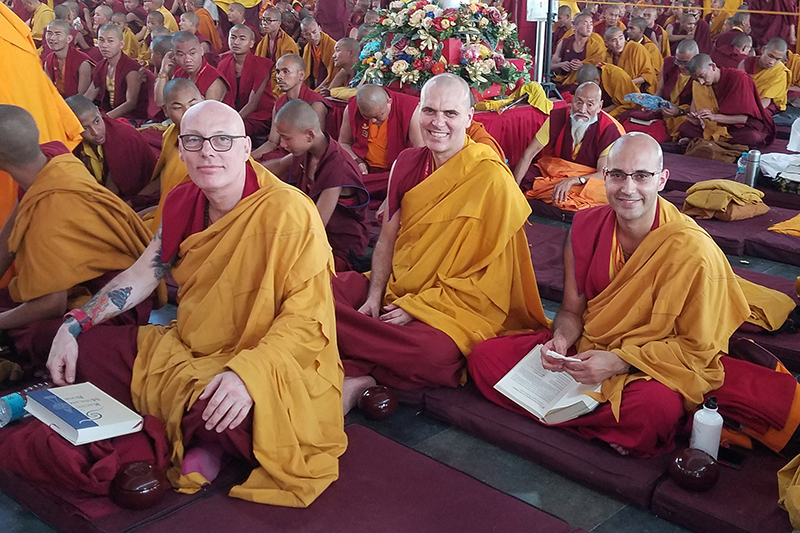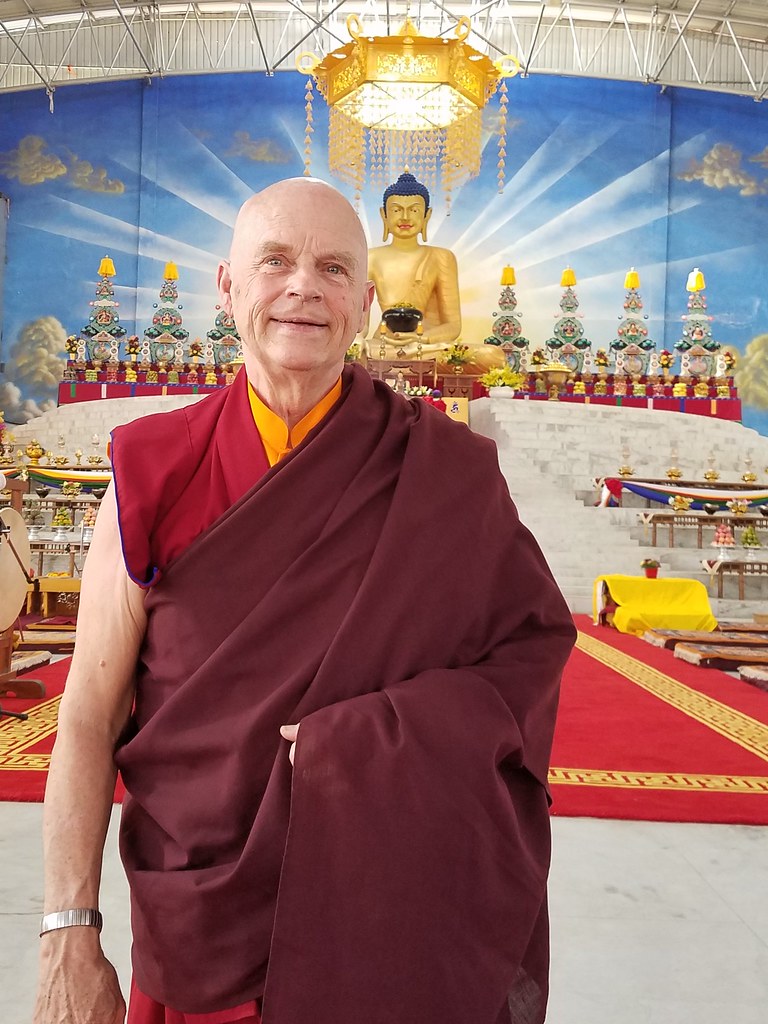
On the lett-hand side of the Monlam Pavillion, beginning in the very first row, is a special section designated for the foreign sangha. Although predominantly from traditionally Buddhist cultures in Asia— such as Korea, Taiwan, Vietnam and China—the seeds of the dharma are germinating slowly in the West and the number of western sangha is growing steadily. This year, for instance, a group of newly-ordained monks and nuns from Samye Ling in Scotland are attending for the first time.
But for some of the western sangha, the roots of Dharma spread back many years and each year at the Monlam, you will find a scattering of long-established western monks and nuns. Some have been coming for years. Some have lived for long periods in India or Nepal, serving as English teachers and volunteers in the monasteries of their teachers. Most have endured significant hardship in pursuit of the dharma. Here are two of their stories.
Tsultrim Yeshe, KTD, USA: Lama Yeshe, from Wisconsin, will celebrate 30 years in the dharma this April. In 1988, after practicing meditation for some months with an American student of Chogyam Trungpa Rinpoche, he heard that Khenpo Karthar Rinpoche would be in Chicago, so he traveled there to take refuge and was, in his words, “blown away.” He ran an upholstery shop for 17 years before entering three year retreat at Karme Ling (with Khenpo Karthar Rinpoche as retreat master) in 1993. While in retreat, he took monastic vows when His Eminence Tai Situ Rinpoche visited.
After retreat, Lama Yeshe returned home and continued working in carpentry (exchanging his robes for overalls, with the permission of Khenpo Karthar Rinpoche) and as a prison chaplain, until his retirement in 2011. He was the only Buddhist chaplain the state of Wisconsin ever employed; he also volunteered at a retirement home for many years; he feels engaged bodhicitta is very important. He has a small and devoted dharma group in rural Wisconsin and is known among the KTD lamas for his devotion to nyungne (fasting) practice. A diabetic, he was once told by a nurse not to engage in fasts, but he has done more than 50 nyungnes, often in cycles of 8 at a time, never having any problems with his blood sugar. He recounts that he has had many health problems over the years, including deep depression before entering the dharma and acute sciatica when he first attended the Monlam two years ago. Nonetheless, anyone who meets Lama Yeshe can testify to his unfailing good humor. This he didn’t come by easily; he had a traumatic childhood with a parent who suffered from mental illness. He recounts that nightmares from his chaotic home life plagued him into his 20s. Lama Yeshe is an example of someone who has cured himself of the afflictions through his dharma practice. His wry sense of humor is contagious; he once wore a button to a KTD teaching that read, “Ask me about my vow of silence.”
When asked why he is willing to return to the Monlam despite the discomfort of long, hot days and difficult travel, Lama Yeshe responded, “I like it here. I find it very powerful. I expected His Holiness to be here, and I like him. I’m extremely impressed with His Holiness, and you can quote me on that.” He remarked with wonder and appreciation at the “extremely profound and excellent” teachings by Gyaltsap Rinpoche and Mingyur Rinpoche this year. Of his guru Khenpo Karthar Rinpoche, Lama Yeshe offered this spontaneous assessment: “We the KTD lamas feel that Khenpo Karthar Rinpoche is extraordinary, and has extraordinary powers.” Lama Yeshe’s joyful wisdom, his devotion and service, and his humility and kindness show us what a meaningful human life can be. He said of the dharma, “I have felt, as I practice, that I’m going home.”
Yeshe Lhamo, UK: Tsünma Yeshe entered the dharma in 1977, taking refuge with Chime Rinpoche in Suffolk, England. She has lived much of her life since that time in India, feeling that the values of western culture make dharma practice especially difficult in the West. Having wished for years to become a nun, she got her chance in 2012 and took monastic vows with His Eminence Tai Situ Rinpoche. She recounts that in her 40 years practicing dharma, there have been many obstacles, but she feels the blessings of her root guru, His Holiness the 17th Karmapa, very keenly.
Tsünma Yeshe first came to the Kagyu Monlam in 2006 and has only missed one Monlam since. She described some of the changes she has seen, including the shift from the Mahabodhi temple to the Monlam Pavilion and the most memorable events for her personally, which included the Milarepa play. She said, “I come for His Holiness. It’s the heart of the Karma Kagyu lineage, the Monlam.” When asked about physical hardships, this nearly eighty-year-old practitioner waved the question away, saying, “I don’t care about that.” Her strong commitment to practice is evident even in casual conversation. She feels her practice has wavered at times, but she has always continued with it. She observed, “There’s nothing like the dharma. The only thing that makes any sense in life is bodhicitta, really. Nothing else in society makes any sense.”
There is still scant support for Buddhist monks and nuns in the West; patrons are few and many monasteries have to charge rent. In addition, there are few dharma communities for western nuns. Tsünma Yeshe hopes for better training for nuns, greater support, and more opportunities for living in community and practicing together. She hopes for female teachers and preceptors to inspire and inform the nuns, so that they can uphold their vows with dignity and precision. Her respect for the Vinaya, for the Karma Kagyu lineage, and for her guru is abundantly evident. Of His Holiness she commented, “His Holiness has been so kind to me. Oh my goodness. So loving. There’s nothing like having a blessing from His Holiness, when you are actually open enough to receive it, which half the time I’m not. I think His Holiness will transform the world, I honestly do.”
Both Lama Tsultrim Yeshe and Tsünma Yeshe Lhamo embody genuine renunciation. Unafraid of hardship, both are joyful and easy to be with. As the Sutra of the Recollection of the Three Jewels says, “The sangha of the Mahayana is engaged in goodness. It is worthy of joined palms. It is a fit object of generosity.” May these and all sangha members always have our support!


































